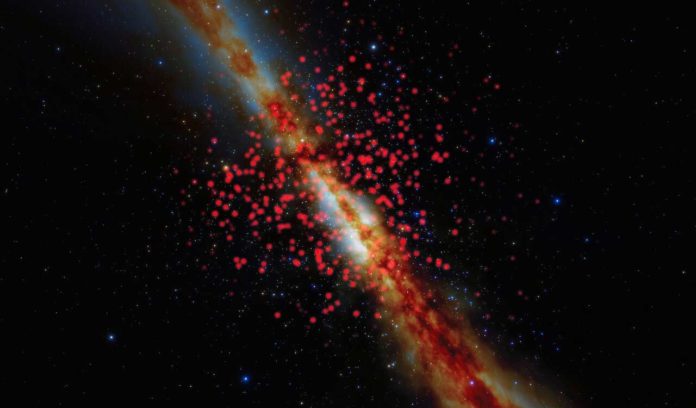An international team of scientists has reported an unprecedented census of 525 cool brown dwarfs within 65 light-years of the Sun, including 38 new disclosures. By determining the distances to all the objects in the census, astronomers have successfully built a 3D map of cool brown dwarfs in the Sun’s local neighborhood.
This breakthrough relied on novel datasets published by the DESI Legacy Imaging Surveys, which blend huge quantities of astronomical data from a variety of sources: archival images from the Nicholas U. Mayall 4-meter Telescope at Kitt Peak National Observatory (KPNO) and the Víctor M. Blanco 4-meter Telescope at Cerro Tololo Inter-American Observatory (CTIO), which are Programs of NSF’s NOIRLab, plus critical sky maps from NASA’s Wide-field Infrared Survey Explorer (WISE). These powerful survey datasets were combined with new distance measurements from the NASA Spitzer Space Telescope to create the best three-dimensional map of the Sun‘s local neighborhood to date.
The faintness and small brown dwarfs make them relatively difficult to find without careful analysis of data from sensitive telescopes — meaning that many have gone undiscovered until now. However, by finding and studying brown dwarfs, astronomers can learn more about star formation and planets around other stars.
J. Davy Kirkpatrick, California Institute of Technology scientist and lead author of the research paper, said, “Brown dwarfs are the low-mass byproducts of the process that forms stars, yet the least massive of them have many characteristics in common with exoplanets. They’re exoplanet laboratories, but since they are usually by themselves and lack the complications caused by a blinding host sun, they’re much easier to study.”
To help identify elusive brown dwarfs in massive datasets, astronomers enlisted the help of the Backyard Worlds collaboration, a worldwide network of more than 100,000 citizen scientists. Astro Data Lab at NOIRLab’s Community Science and Data Center (CSDC) was instrumental in providing these volunteers with data, allowing citizen scientists to easily hunt through the astronomical archives searching for brown dwarf candidates. The Backyards Worlds project announced the discovery of almost 100 nearby cool brown dwarfs in August last year, and today’s announcement is a continuation of their work.
Aaron Meisner, a co-author of this study and co-founder of Backyard Worlds, said, “The Backyard Worlds project shows that the general public can play an important role in cutting-edge astronomy. Volunteers ranging from high school students to retired engineers are helping uncover groundbreaking discoveries lurking in existing telescope data.”
The study results provide more evidence that the Sun’s immediate neighborhood (within roughly seven light-years) is rather unusual more evidence that the Sun’s immediate neighborhood (within roughly seven light-years) is rather unusual. While most Milky Way stars are red dwarfs, primary outcomes uncovered that the Sun’s closest neighbors are significantly more assorted, with various kinds of articles, from Sun-like stars to Jupiter-like brown dwarfs, showing up in generally equivalent numbers.
The new outcomes add to this disparity by turning up no more extremely cold brown dwarfs like our close-by neighbor WISE 0855, the coldest known brown dwarf, despite the fact that the team expected to discover at least several more within 65 light-years of the Sun, given the new investigation’s affectability.
Meisner said, “This result hints at the possibility that yet more cold brown dwarfs have so far eluded detection. Thanks to volunteers’ efforts around the world, we have a better idea than ever of the objects in our cosmic backyard. But we suspect that more of the Sun’s cold and close neighbors still await discovery within our vast data archives.”
Journal Reference:
- J. Davy Kirkpatrick et al. The Field Substellar Mass Function Based on the Full-sky 20-pc Census of 525 L, T, and Y Dwarfs. arXiv:2011.11616
